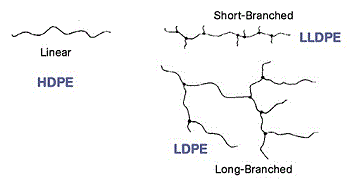 |
| LDPE structure vs HDPE structure |
Hermes started off by explaining, correctly, that LDPE is simply short for low-density polyethylene:
"LDPE is an acronym for low-density polyethylene. This type of plastic can be identified in many products we use with the resin code, or recycling number, 4."Well, that's mostly correct, though we'd be remiss if we didn't point out to someone with a BA in English that LDPE is not an acronym, it's an initialism.¹ But enough about that... let's take a look at Amanda's post. She continues by citing the American Chemistry Council to explain that,
"...LDPE is primarily used in film applications because it is tough, flexible and relatively transparent. LDPE is also used to produce some flexible lids and bottles as well as in wire and cable applications."Again, true (except that she changed "wire and cable insulation" to "wire and cable applications"). She then goes on to natter for a few sentences about LDPE's properties, its applications, recycling LDPE, and products made of the stuff. We thought she'd already covered that last, but she apparently hadn't yet reached her minimum word count. Probably all correct, through we didn't bother to fact-check. We had something else in mind...
What this liberal arts type didn't do, unfortunately, is explain LDPE. You know, answer questions like
- What is polyethylene?
- Why is this stuff called "low-density"?
- Is there "high-density" polyethylene? How are the two different?
- Polyethylene is a plastic polymer made of chains of the hydrocarbon molecule ethylene.
- The polymer chains in LDPE have lots of branches and twists, which means that they don't pack closely together. This means LDPE plastic is flexible while remaining strong
- Yes, there is something called high-density polyethylene (HDPE). HDPE polymer chains don't branch, so they pack more closely together than LDPE chains. HDPE tends to be tougher and less flexible than LDPE.
¹ Acronyms are initials or parts of words that can be pronounced, such as radar (radio detection and ranging) or scuba (self-contained underwater breathing apparatus). LDPE is just initials, because no one (except maybe Amanda) thinks it's pronounced "lead-pee."
copyright © 2017-2022 scmrak

No comments:
Post a Comment